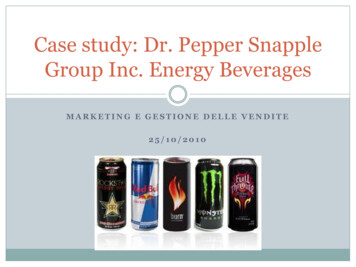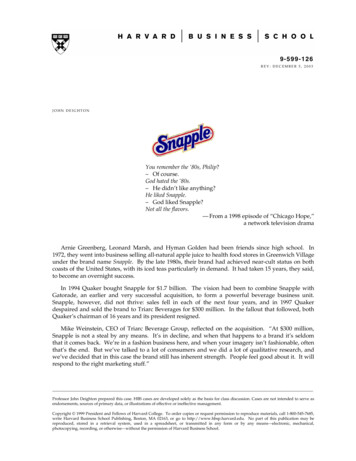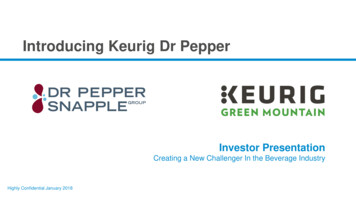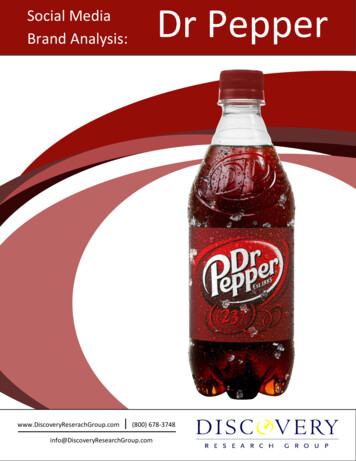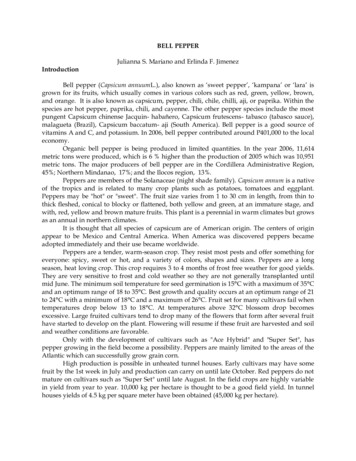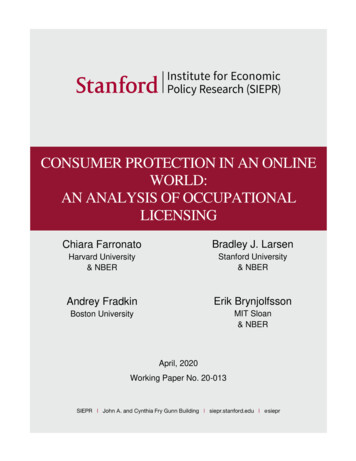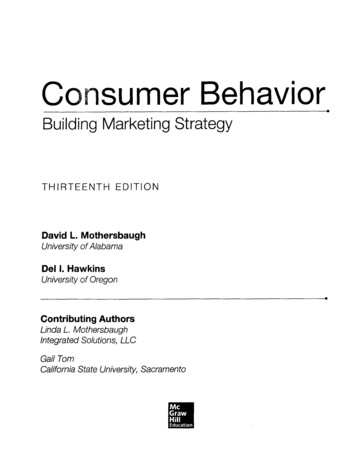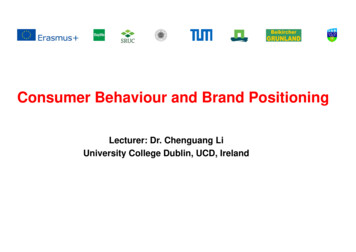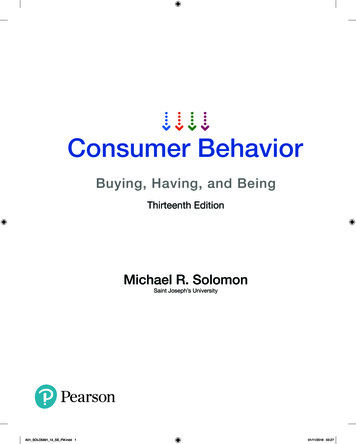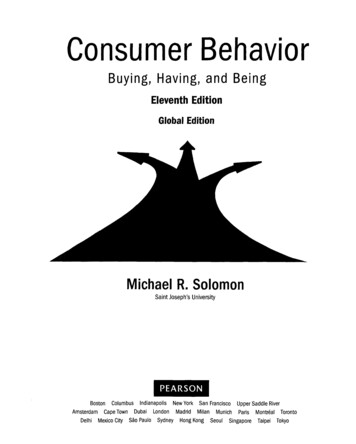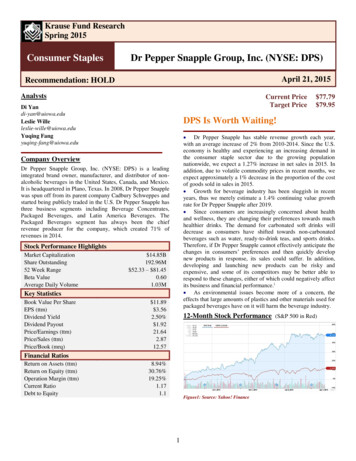
Transcription
Krause Fund ResearchSpring 2015Consumer StaplesDr Pepper Snapple Group, Inc. (NYSE: DPS)Recommendation: HOLDAnalystsCurrent PriceTarget PriceDi Yandi-yan@uiowa.eduLeslie Willeleslie-wille@uiowa.eduYuqing Fangyuqing-fang@uiowa.edu Dr Pepper Snapple has stable revenue growth each year,with an average increase of 2% from 2010-2014. Since the U.S.economy is healthy and experiencing an increasing demand inthe consumer staple sector due to the growing populationnationwide, we expect a 1.27% increase in net sales in 2015. Inaddition, due to volatile commodity prices in recent months, weexpect approximately a 1% decrease in the proportion of the costof goods sold in sales in 2015. Growth for beverage industry has been sluggish in recentyears, thus we merely estimate a 1.4% continuing value growthrate for Dr Pepper Snapple after 2019. Since consumers are increasingly concerned about healthand wellness, they are changing their preferences towards muchhealthier drinks. The demand for carbonated soft drinks willdecrease as consumers have shifted towards non-carbonatedbeverages such as water, ready-to-drink teas, and sports drinks.Therefore, if Dr Pepper Snapple cannot effectively anticipate thechanges in consumers’ preferences and then quickly developnew products in response, its sales could suffer. In addition,developing and launching new products can be risky andexpensive, and some of its competitors may be better able torespond to these changes, either of which could negatively affectits business and financial performance. i As environmental issues become more of a concern, theeffects that large amounts of plastics and other materials used forpackaged beverages have on it will harm the beverage industry.Dr Pepper Snapple Group, Inc. (NYSE: DPS) is a leadingintegrated brand owner, manufacturer, and distributor of nonalcoholic beverages in the United States, Canada, and Mexico.It is headquartered in Plano, Texas. In 2008, Dr Pepper Snapplewas spun off from its parent company Cadbury Schweppes andstarted being publicly traded in the U.S. Dr Pepper Snapple hasthree business segments including Beverage Concentrates,Packaged Beverages, and Latin America Beverages. ThePackaged Beverages segment has always been the chiefrevenue producer for the company, which created 71% ofrevenues in 2014.Stock Performance Highlights 14.85B192.96M 52.33 – 81.450.601.03MKey StatisticsBook Value Per ShareEPS (ttm)Dividend YieldDividend PayoutPrice/Earnings (ttm)Price/Sales (ttm)Price/Book (mrq) 11.89 3.562.50% 1.9221.642.8712.5712-Month Stock Performance (S&P 500 in Red)Financial RatiosReturn on Assets (ttm)Return on Equity (ttm)Operation Margin (ttm)Current RatioDebt to Equity 77.79 79.95DPS Is Worth Waiting!Company OverviewMarket CapitalizationShare Outstanding52 Week RangeBeta ValueAverage Daily VolumeApril 21, 2015April8.94%30.76%19.25%1.171.1Figuee1: Source: Yahoo! Finance1
After we analyzed Dr Pepper Snapple by integrating the U.S.economy, the beverage industry, and its company specificperformance, we expect a fair value of 79.95 for Dr PepperSnapple in 2015, which is very similar to the current stock price.Therefore, we recommend holding Dr Pepper Snapple. The U.S.economy is expected to grow and continue to be healthy in theshort term. However, since the beverage market in the U.S. isalready mature, the sluggish growth of the beverage industry inthe U.S. slows down the growth of companies within it.Therefore, it is better for Dr Pepper Snapple to seek overseasopportunities, although there are risks associated with suchexpansion like differences in currency rates and changes ingovernmental policies. Although disposable income is expectedto increase, consumer spending has still been soft in recentmonths.ii Therefore, we suggest that investors can still wait andsee how Dr Pepper Snapple reacts to the risks it exposes and howit creates its own strategic advantage over other companies.Figure 3: Source: Federal Reserve Bank of St. LouisvBased on the projections of authority institutions, including theInternational Monetary Fund, the European Commission, and theFederal Reserve, the Real GDP in 2015 will increaseapproximately 3.15%, and 3.06% in 2016. vi Furthermore, newjob openings will give more opportunities to people and boostthe economy. However, the impact of the federal funds rateadjustment in 2015 on stocks, along with the economicslowdown in the Eurozone, will also slow down the growth ofthe U.S. GDP. In addition, the decrease the CCI in January andsoft spending in February indicate that people prefer saving morethan spending. Therefore, we predict that the Real GDP willincrease by 2.6%, as it did in the last quarter of 2014, within thenext six months. We also estimate that the Real GDP willincrease approximately 3.0% in the next 2-3 years.Gross Domestic ProductReal Gross Domestic Product is a vital and commonly useddeterminant to measure the economic performance of a country.The Real GDP is defined as the nominal GDP adjusted by theinflation rate that reflects the market value of goods and servicesmeasured annually. iii Since nearly two-thirds of GDP is drivenby individual’s consumption, it is an important indicator of theconsumer staples sector.Unemployment RateWe think it is an important indicator because unemploymentrates can reflect the well-being of an economy in a country. Forexample, during the 2007-2009 recession, the unemploymentrate was remarkably high and reached 10% in 2009.Alternatively, when an economy stays healthy, it experiences alow unemployment rate.According to the graph below by the Federal Reserve Bank of St.Louis, the U.S. Real GDP has historically remained in an upwardtrend except during the recessions.As seen in the graph below by the Bureau of Labor Statistics, theunemployment rate gradually recovered to a lower rate after therecession in 2008 and 2009.viiFigure2: Source: Federal Reserve Bank of St. LouisivFigure 4: Source: Federal Reserve Bank of St. LouisviiiBelow is a chart showing the percentage change of Real GrossDomestic Product. As seen in the chart, the Real GDP increasedby 2.5% on average in 2014, with -2.1%, 4.6%, 5.0%, and 2.2%in quarters 1-4 respectively.Since 2010, the unemployment rate has continued to decrease byan average of 0.1% each year. Additionally, the unemploymentrate decreased to 5.5% by February this year and held steady at5.5% in March. Based on the projections of International2
Monetary Fund, European Commission, and the Federal Reserve,the unemployment rate in 2015 will be approximately 5.6%, and5.4% in 2016. ix Referring to the news posted on the Board ofGovernors of the Federal Reserve System, “labor marketconditions have improved further with strong job gains and alower unemployment rate.” Hence, we predict that theunemployment rate will probably not change a lot in the shortterm, it will only decrease by 2%, as compared to 5.8% in thefourth quarter of 2014 since jobless people still need time to findwork. In the long term, our group predicts that theunemployment rate will remain low and stay around 5.5%.xWe believe the CPI for the consumer staples industry willcontinue to steadily increase by about 2% in the short term, andby 2.2% in the next two-three years. We believe it will be verysimilar to the national expected inflation rate because there willonly be a small level of growth within the industry. Although anincrease in the minimum wage may cause the CPI to decrease tosome degree, it will likely be offset by increases in the price ofconsumer goods. xvi , xvii In conclusion, an increasing CPI willcause consumers to have less confidence in the consumer staplesindustry because they will have less purchasing power.Interest RateWe believe that the low unemployment rate will have positiveimpacts on consumer staple sectors. Lower unemployment ratecan indicate an increase in purchasing power of customers, andthus promotes consumer spending.The federal funds rate is the interest rate at which banks andother depository institutions lend money to each other.Increasing the federal funds rate will decrease the supply ofmoney and increase short-term interest rates, and vice versa.xviiiTherefore, the federal funds rate can be seen as a benchmark foranalyzing interest rates in financial markets. The federal fundsrate has been at a low level of 0.25% for more than 4 years afterthe 2008 financial crisis.Consumer Price IndexThe CPI is important for understanding the consumer staplesindustry because it reflects changes in price due to rising costs offood, beverages, drugs, personal and household items, tobacco,and alcohol.xi The CPI has risen at a relatively steady rate for thelast 10 years, due in part to a rise in food and beverage prices.The price of meat, grains, fruits and vegetables, and dairyproducts have increased in the last several years due to droughts,disease among animals, extremely cold weather, and a citrusgreening disease in Florida. In general, the price of all foods andbeverages using ingredients from these categories were affectedby the calamities. This is due to the fact that the price of productsnot directly affected rose when more people started to turn tocheaper options, thusly causing them to go into higher demand. xiiFigure 6: Source: Trading Economics U.S. Bureau of Economic AnalysisSince the minimum wage has also increased substantially in thelast ten years, prices within the beverage industry have increasedbecause the average American can afford to pay higher prices fortheir drinks.xiiiAccording to the data retrieved in Brankrate (n.d.), the prime ratehas been 3.25% for a year. Therefore, we believe that within thenext 6 months, the prime loan rate will remain unchanged orchange very little until the federal funds rate is adjusted to someextent. We are more likely to expect the interest rate at the end ofJune 2015 to be 3.20%-3.30%. xix Thus, companies in theconsumer staples sector still can save a lot in cost of debt, andthis will give rise to a good stock performance within 6 months.This is due to the fact that a lower cost of debt will result inlower interest expenses and more free cash flows to raiseinvestors’ estimate for the company’s stock price.Below is a graph representing the steady rise in the CPI from1990-2014.xivAccording to the long-term forecast from Mortgage-X, the primeloan interest rate will increase to approximately 4.00% at the endof 2015. We expect the interest rate to achieve at least 4.75% inthe next 2-3 years.xxDemographicsThe population in America is expected to increase by another100 million people by 2050. The number of people aged 65 andolder are expected to increase from 13%-20% by the middle ofthe century, but the working class is estimated to increase by42%. Birth rates are also expected to escalate causing a smallpopulation bubble. This is because the children of the youngestbaby boomers will begin to have children of their own, and theFigure 5: Source: Federal Reserve Bank of St. LouisCPI increased 2.04% last year and 1.93% on average in the lastthree years. xv So, the inflation rate is steadily increasing.3
grandchildren of the early baby boomers will begin to havebabies as well. Birth rates in the U.S. have been higher in the lastdecade than they have in the last 45 years. xxiBelow is a chart representing expected population growth in theUnited States between 2010 and 2050.xxiiFigure 8: Source: Fidelity, “Consumer Staples”Figure 7: Source: The American CenturyIndustry OverviewGreater amounts of consumer goods, including staple items suchbeverages, will need to be produced to support such largepopulation growth. This will cause the consumer staples industryto grow, but it will be at a very gradual rate as the populationexpands throughout the next 35 years. xxiiiWe expect the industryto grow by approximately 1.5-2% in the next 2-3 years due thepopulation boom and the rise in Real GDP.The non-alcoholic beverage industry in the consumer staplessector covers eight main product lines: carbonated soft drinks,sports beverages, bottled water, energy drinks, fruit drinks,value-added water, ready-to-drink tea, ready-to-drink coffee.xxviCapital Market OutlookThe market outlook for the beverage industry is positive. RealGDP is expected to increase by 3% in the short term, giving riseto a healthier economy. Unemployment is expected to decreaseby .2%, which will also give a boost to consumer staplesindustries and increase purchasing power. CPI is anticipated toincrease by 2%, and interest rates will remain low. We believethat the positive changes in Real GDP and unemployment rateswill outweigh the effects of a rising CPI and low interest rates onthe industry. The population is also expected to growconsiderably in the next 20 years, which will raise demand forstaple items.xxiv For these reasons, we estimate that the beverageindustry will grow by approximately 1.4% in the next 5 years.We believe it will perform better in 5 years than in the next yearbecause an increase in population and employment rates will taketime.Figure 9: Source: Beverage Industry Analysis 2014Major players, including Dr Pepper Snapple, Coca-Cola,PepsiCo, Monster, and National Beverage, in this matureindustry compete with each other intensely. However, thebeverage industry is quite a defensive industry that it is notsensitive to the changes in economic and financial environment.Companies in this industry create revenues simply bymanufacturing beverages, though some companies, like Monster,will outsource their manufacturing process and earn the marginsfrom such.Industry Trend and Recent DevelopmentsBased on the Beverage Industry Analysis in 2014, people tend tochoose more healthy drinks. For example, the consumption ofenergy drinks, soft drinks, and high-caloric coffee has beenfalling, while the price of bottled water has remainedcompetitive. xxvii According to respondents of the beverageindustry’s annual New Product Development Outlook survey,51% of companies plan to launch
It is headquartered in Plano, Texas. In 2008, Dr Pepper Snapple was spun off from its parent company Cadbury Schweppes and started being publicly traded in the U.S. Dr Pepper Snapple has three business segments including Beverage Concentrates, Packaged Beverages, and
